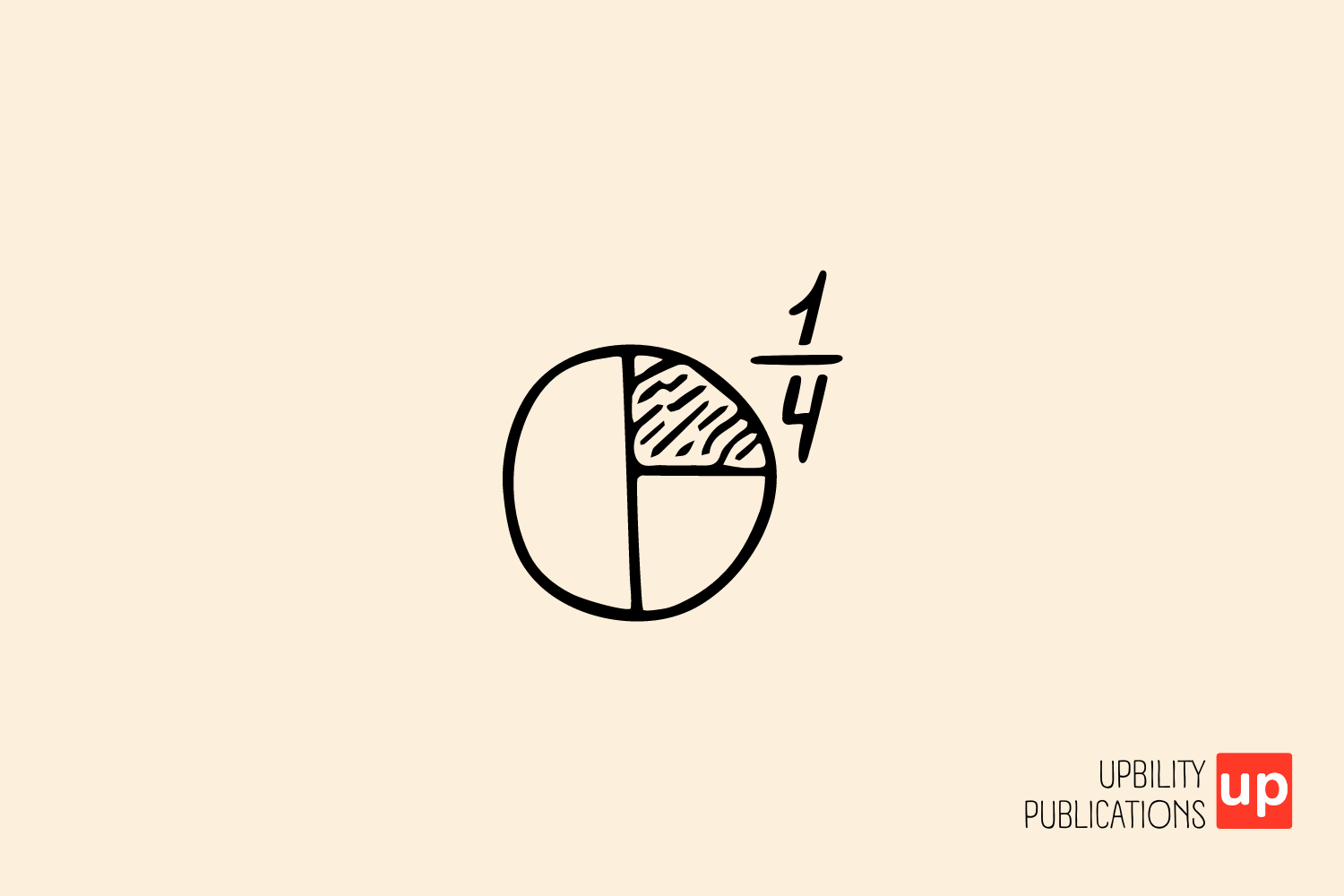Need to know how to do addition between fractions? In this practical guide, you will learn how to add fractions with the same denominator and with different denominators through simple rules and clear examples.
Main Elements
- To add fractions with the same denominator, simply add the numerators while keeping the denominator unchanged.
- To add fractions with different denominators, it is necessary to find the lowest common multiple (mcm) of the denominators, convert the fractions and then add the numerators.
- Addition of fractions follows important mathematical properties such as commutative, associative and invariant, which make it easier to understand and perform the operations.
Addition between fractions with the same denominator

Addition between fractions with the same denominator is the simplest starting point. The basic rule is that you add the numerators while keeping the denominator unchanged. For example, if you have 8/5 and 3/5, the sum will be 11/5.
Let us consider another example to further clarify. If you add 2/7 and 4/7, the denominator remains 7 and the numerators add up: 2 + 4 = 6. Thus, 2/7 + 4/7 = 6/7. This method is straightforward and requires no further complex calculations.
In some cases, you may obtain a fraction that is already reduced to the lowest denominator, such as 3/7 + 4/7 = 7/7 = 1. This makes the addition of fractions with the same denominator an excellent starting point for those who are new to this concept.
Additions between fractions with different denominators
When it comes to fractions with different denominators, the process becomes slightly more complicated. The key is to find a common denominator, which is often the least common multiple (mcm) of the denominators.
For example, if we have to add 3/4 and 2/5, we first have to find the mcm of 4 and 5, which is 20. We then convert the fractions into equivalents with denominator 20: 3/4 becomes 15/20 and 2/5 becomes 8/20. Now we can add up the numerators: 15 + 8 = 23. So 3/4 + 2/5 = 23/20.
Another example would be the sum of 7/10 and 3/15. The mcm of 10 and 15 is 30. Let us convert the fractions: 7/10 becomes 21/30 and 3/15 becomes 6/30. The sum will then be 27/30, which can be reduced to 9/10.
This method ensures that the fractions are added correctly, keeping the mathematical process consistent and accurate. Once the common denominator is found, the rest of the operation is similar to that of fractions with the same denominator.
Sum of complementary fractions

Complementary fractions are a fascinating concept: they are fractions whose sum is equal to 1. This is useful in many applications, such as in the division of resources into equal parts or in the second step of a process.
For example, fractions 1/6 and 5/6 are complementary because when added together they give 1. Another example are fractions 4/7 and 3/7, which when added together give 7/7, i.e. 1.
Finding complementary fractions can be useful in many practical contexts. For example, if you have 3/8 of a pie and want to know how much is missing to get to the whole, the answer is 5/8. This method is simple and intuitive, making it easy to calculate the missing quantities.
Calculating the common denominator
To sum fractions with different denominators, it is essential to find the common denominator, which is obtained by calculating the lowest common multiple (mcm) of the denominators. This is done by decomposing the denominators into prime factors and considering the multiple between the denominators.
For example, to find the mcm of 12 and 15, we decompose 12 into 2^2 3 and 15 into 3 5. The mcm will be 2^2 3 5 = 60. This becomes the common denominator for fractions.
Once we have found the mcm, we can convert the fractions to the new denominators and add them up easily. This method ensures that the fractions are calculated correctly and reduces the possibility of mathematical errors.
Adding a fraction to a whole number

Adding a fraction to a whole number requires a little trick: you have to convert the whole number to a fraction. This is done by putting the whole number as the numerator and 1 as the denominator. This operation can only be taken once to obtain the correct result.
For example, to add 3 and 1/4, we convert 3 to 3/1. Then we find a common denominator, which in this case is 4, and convert 3/1 to 12/4. Now we can add 12/4 + 1/4 = 13/4.
Another example is the sum of 5 and 2/3. We convert 5 to 5/1 and find the common denominator of 3, obtaining 15/3. The sum will then be 15/3 + 2/3 = 17/3.
This method makes it easy to add fractions and whole numbers without confusion.
Properties of addition with fractions
Addition of fractions follows some fundamental mathematical properties: the commutative, associative and invariant property. These properties help to better understand the behaviour of fractions in mathematical operations.
The commutative property states that by changing the order of the addends, the result of the addition does not change. For example, 2/5 + 3/5 = 3/5 + 2/5.
The associative property states that the sum of three or more fractions does not change if you change the order of the addends. For example, (1/4 + 2/4) + 3/4 = 1/4 + (2/4 + 3/4).
The invariant property states that if we add or subtract the same quantity to both terms of a fraction, the overall value will remain the same. This concept is important to bear in mind when working with fractions and dealing with subtraction. These properties make the addition of fractions a logical and predictable process.
Practical exercises on addition between fractions
To master addition between fractions, practice is key. There are numerous online resources that offer detailed exercises with solutions, which are useful for better understanding the steps of the operations. In addition, the use of a calculator can help to check results.
For instance, websites such as Khan Academy offer interactive exercises and detailed explanations that can help reinforce understanding of addition between fractions. These exercises are structured to guide you step by step through the process of adding fractions.
Starting with simple exercises and then moving on to more complex problems is a great way to develop your skills. By practising regularly in the lessons, you will gain confidence and accuracy in your calculations.
Summary
We explored the different facets of addition between fractions, from bases with the same denominator, to fractions with different denominators, to complementary fractions and addition with whole numbers. We have also seen how to calculate the common denominator and the mathematical properties governing these operations.
Understanding addition between fractions is a fundamental step in mastering mathematics. With practice and the use of the right resources, it is possible to become proficient in this field and apply this knowledge in various everyday contexts.
Hopefully, this guide has provided you with the tools you need to tackle addition between fractions with confidence. Keep practising and exploring new problems to keep you interested and improve your mathematical skills.
Frequently Asked Questions
How can I add fractions with the same denominator?
You can add fractions with the same denominator by simply adding the numerators and keeping the denominator unchanged. For example, 8/5 + 3/5 = 11/5.
What is the simplest way to add fractions with different denominators?
The simplest way to add fractions with different denominators is to find the lowest common multiple (mcm) of the denominators, convert the fractions to the new common denominators and add the numerators. Good practice!
What are complementary fractions?
Complementary fractions are those whose sum is equal to 1, such as 1/6 and 5/6.
How do I add a fraction to a whole number?
To add a fraction to a whole number, convert the whole number into a fraction by putting the whole number as numerator and 1 as denominator, then follow the rules of addition between fractions. Good work!
What are the properties of addition with fractions?
The properties of addition with fractions include commutative, associative and invariant. They are fundamental for correctly performing operations with fractions.
Original content from the Upbility writing team. Reproduction of this article, in whole or in part, without credit to the publisher is prohibited.









